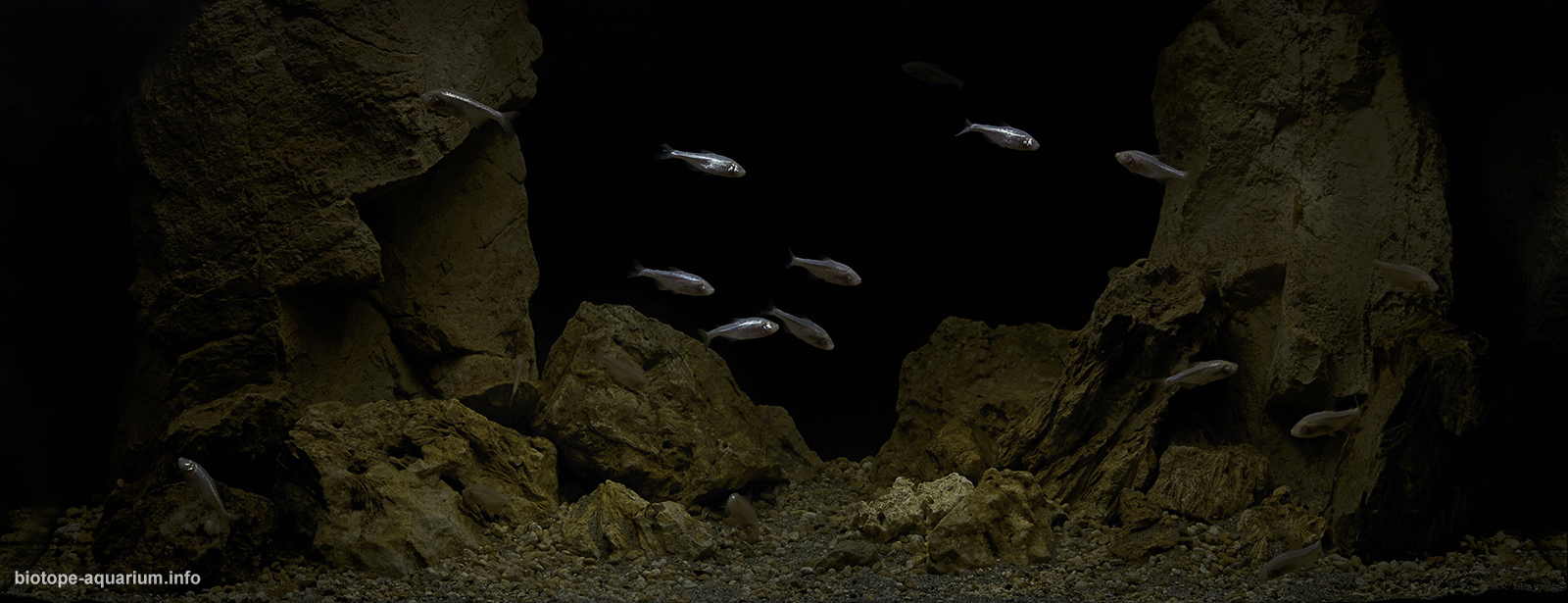Underground waters of Cueva Chica Cave, San Luis Potosi Province, Mexico
_st place in Biotope Aquarium Design Contest 2022

Volume of aquarium: 156 L
Dimensions of aquarium: 100*39*40 cm
List of fishes: Astyanax mexicanus
Description of Decorations and Substrate: Natural large and small chipped stones, similar in shape and color to the stony rock of the cave; natural light sand, similar to the soil at the bottom of the cave.
Description of Equipment: JBL CristalProfi greenline e901 external filter, LEDDY SMART LED II SUNNY 6 W, AQUAEL PLATINIUM HEATER 200 W, OXYBOOST 200 plus two-channel compressor.
Water Parameters: pH 7,2, dH 16°; t 24°C
Additional Info:Regular water changes (30% every 3 weeks), fish are fed every other day with live, frozen or dry food.
Aquarium video:
Description of the Area Surrounding the Biotope: The Sierra del Abra Tanchipa biosphere Reserve is a protected natural area in northeastern Mexico. It is located in the Huasteca Potocina region of the state of San Luis Potosí, in the eastern foothills of the Eastern Sierra Madre.
The reserve protects an area of 167.58 km2 in the Sierra del Abra Tanchipa. The Sierra stretches from north to south, the easternmost of the eastern ranges of the Sierra Madre. The coastal plain lies to the east, between Sierra Leone and the Gulf of Mexico. Altitudes in the reserve range from 300 to 850 meters. The Sierra is a steep slope in the east facing the coastal plain and gradually descends to the west. The Sierra is composed primarily of sedimentary limestone, a porous rock that facilitates the infiltration of rainwater into groundwater basins and underground drainage. The Sierra is drained by tributaries of the Rio Verde, which is part of the Panuco river system. The state of San Luis Potosi is located in the northern part of the center of the country, in the central part of the Mexican Highlands, with the exception of the southeastern part of the state – it lies on the plateau of the Panuco River.
Description of the Underwater Landscape of the Biotope:The bottom of the cave is partly sandy, partly rocky, and sometimes muddy. In the underwater landscape there are large stones and small chipped ones. The sand is light, the water is clear, there are no aquatic plants.
Description of the Habitat Parameters: The blind cave tetra inhabits Eastern Mexico. It lives only in those places where it finds many shelters – underground reservoirs, flooded caves and grottoes.
Most of the state of San Luis Potosí is dominated by arid and semi-arid conditions. Average temperatures fluctuate around +18 °C. In May the temperature can reach +30 °C, and in January +3 °C. The average rainfall is about 800 mm/year.
The climate in the Sierra del Abra Tanchipa Reserve is tropical, including warm humid and warm sub-arid Köppen climates. The average annual temperature is 24° C. The average annual rainfall in the reserve ranges from 1200 mm to 1500 mm and is highest during the summer months.
The reserve is in the Veracruz wet forest ecoregion, which stretches across the coastal bay plain and foothills of southern Tamaulipas, eastern San Luis Potosi, and the northern states of Veracruz. The reserve is located in the transition zone between the tropical and temperate biogeographic regions of North and South America and is home to animals and plants characteristic of both areas and some specific to the transition zone.
Water parameters in the cave: T 18-24, pH 7.0-8.0; dH 16-25°.
List of Fishes and Invertebrates Occurring in the Nature Biotope: Astyanax mexicanus
Threats to the Ecology of the Biotope: There is no threat to the environment yet, because the biotope is located in the Sierra del Abra Tanchipa reserve, but the threat may come from human activities (destruction of caves, water poisoning).
Astyanax mexicanus is an important evolutionary model for the study of biological processes, including the circadian rhythm, as its ancestral form lives on the surface of the water and coexists with isolated forms that inhabit caves. Thus, it allows a physiological and molecular comparison of the two forms of this fish species. The blind tetra has completely non-existent day/night cycles, hence lacking the locomotor rhythms normally induced by the circadian clock. This indicates dysfunction or a decrease in their behavioral rhythm. The lack of light causes several difficulties, whether visually, spatially, or even in reproduction. In addition, animals living in aperiodic environments, such as Astyanax mexicanus, do not have a selective advantage for a functioning circadian clock. The connection between an organism and its environment is important only if the ecological cycles are constant and regular. Thus, their lifestyle leads to a phenotype with degenerative characteristics such as eye loss and pigmentation. On the other hand, other traits are better developed, such as heightened sense of smell and mechanical sensitivity. Until now, two evolutionary processes determine the phenotype of fish: firstly, natural selection, which says that losses at the phenotype level are beneficial for the animal, and secondly, genetic drift, which leads to a regression of the trait due to the accumulation of resulting mutations. Finally, over time it was found that the fish were slightly more active during the day. Thus, the hypothesis arises that the molecular circadian rhythm of the blind tetra works differently and is independent of motor activity, as well as other outputs such as metabolism. Therefore, it is important to preserve this species.
Sources of Information:
https://www.researchgate.net/figure/Astyanax-caves-cavefish-populations-and-habitats-a-A-map-showing-the-distribution-of_fig2_342871838
рыба: https://ru.frwiki.wiki/wiki/Tétra_aveugle
https://en.wikipedia.org/wiki/Mexican_tetra
https://en.wikipedia.org/wiki/Mexican_tetra
https://www.fishbase.de/summary/Astyanax-mexicanus.html
биотоп: https://www.pinterest.ru/pin/390757705160774320/
https://translated.turbopages.org/proxy_u/en-ru.ru.f053bdce-61ebe78b-69283e68-74722d776562/https/en.wikipedia.org/wiki/Sierra_del_Abra_Tanchipa_Biosphere_Reserve
видео: https://yandex.ru/video/preview/?text=слепая%20тетра%20в%20конкурсе%20аквариумов&path=wizard&parent-reqid=1642591293319591-3359123877009418964-sas3-0789-748-sas-l7-balancer-8080-BAL-1598&wiz_type=vital&filmId=5404798708898736071
